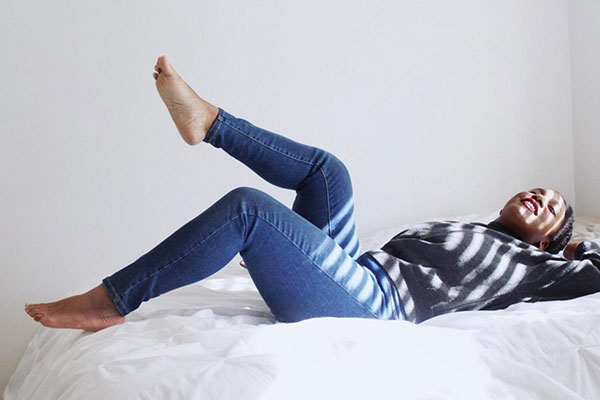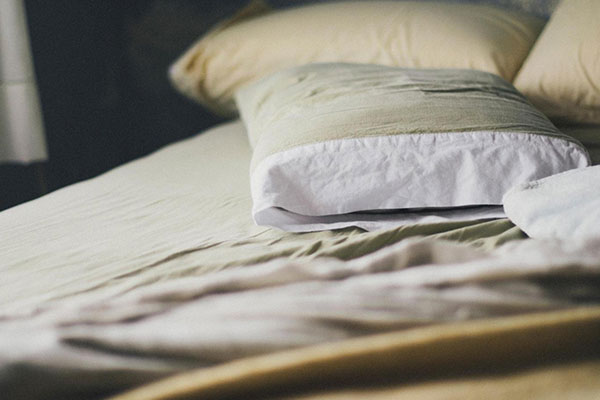We all know that your pose determines your sleep quality and influences your overall well-being.
And when it comes to sleeping on your back, there are many awesome benefits.
However, if you are not used to sleeping in such a pose, training yourself might be tough.
Do not fear! Today, you are going to learn 7 effective steps, which will help you start sleeping on your back and feeling comfortable while doing so.
Benefits Of Sleeping On Your Back
The debate about which sleeping position is the best is still going. Some people say that sleeping on your left side helps with digestion. Others claim that only back sleeping is good for you. And some believe that you should not force yourself. You have to sleep in whatever position you find comfortable. Your regular pose is the best for you.
Now, while we cannot know for sure how we should sleep properly, we are aware of the countless benefits of sleeping on our backs. Here are some of them:
Back sleeping is great for both your spine and neck:
- When you sleep on your back, a couple of things happen. First off, your head, neck, and spine align. Secondly, your body weight is more evenly distributed. Finally, your lower back starts experiencing less stress. And that’s why lying on your back is so beneficial.
- Your back is not being forced into any curvy poses; it remains in a neutral and relaxed state. And that is what makes your back (and neck, since they properly align) stay healthier.
This pose can help you keep your youth longer:
- Have you heard what your pillow can do to you? No, I will tell you. When sleeping on your side or stomach, your face is being pressed into the pillow. And no matter how soft it is, it will still rub against your face and make it “squished.” This leads to some additional wrinkles appearing. They might be small, but they’re still there, trust me.
- At the same time, when you are lying on your back, your face isn’t pressed against anything, which means nothing is promoting the lines on the skin. Some people (beauty gurus mostly) also believe that when you sleep on your back, gravity kind of pulls your skin down, which works as a natural lifting. Who knows, maybe that’s true too.

The Youth Longer Pose – Image/Shutterstock
“There are so many special pillows on the market dedicated to making users sleep on the back. You can see such names as ”Anti-Wrinkle Pillow” or “Anti-Aging Pillow.” Some of them are designed to keep your head cushioned on both sides to prevent it from turning to the side. Others have a very specific shape. It allows users to sleep on the side but keeps the face elevated while supporting the neck. As a result, your face is not pressed into the pillow, even if you are sleeping on your side.”
You May Also Like – 11 Best Flank Exercises and Bubble Butt Workouts: 13 Butts Exercises For Firmer Glutes
It helps relieve muscle pressure:
- Especially in your neck and shoulders. This has to do, again, with the neutral spine alignment. When your body is in a neutral position, your muscles don’t need to be flexed in order to support it. So, they relax more, and the muscle pressure relieves.
It keeps your pillow cleaner and, consequently, safer:
- You know you might drool during the night. Let’s admit it: we all probably do that. This makes your pillow accumulate more moisture, creating a super friendly environment for dust mites and other nasty things.
- So, when your face is not in your pillow, and you are on your back, the drooling stops, which makes your pillow a little bit cleaner and safer.
This sleeping position makes your face less swollen in the morning:
- (if you are one of those people who regularly experience such an issue), The same rule applies to puffy eyes. This, again, is linked to pressing your face into the pillow.
- When lying on the side or stomach, the fluid accumulates in those face areas where the pressure is applied. Obviously, this makes you look like a puffy bun in the morning. By sleeping on your back, you can avoid that.
It helps reduce the acid reflux:
- When you are on your back, your head is supported by the pillow. In the majority of cases, the head is slightly elevated above the rest of the body. This prevents the acid from coming back up since the stomach is lower than your esophagus. This is science, I swear!
How to Train Yourself to Sleep On Your Back?
Now, if you are determined to train yourself to sleep on your back, you need to know that the path isn’t going to be the easiest one. If your body is used to sleeping, let’s say, on one side, switching to back sleeping will make you feel uncomfortable at first. Your body will do everything to get back to the comfortable pose it is so used to.
However, with a little bit of perseverance, you can take everything under control. So, here are 7 effective steps you can take to make yourself sleep on your back:
Create a barricade for your head (and maybe neck and shoulders).
Here’s the deal:
When you want to turn to your side, usually the first thing that turns is your head, then the rest of your body follows it and rolls over. Therefore, to prevent yourself from rolling over in your sleep, you need to fix your head.
How do you do that? Use your pillows! If you can find some extra ones, tuck them around your head and maybe even on both sides of your neck and shoulders. As an extra step, you can also create barriers at each side of your body using larger pillows.
I know, that’s a lot of pillows. However, there is an alternative. There are special pillows on the market, which help people sleep on the back. Keep in mind that those pillows are rather pricey (especially when compared to the regular ones). But, if you don’t want to bother with building barricades, this option might be the best for you. Simply invest in one special back-sleeping pillow, and you’re all set.
“It can be challenging to find so many extra pillows. So, this is when you need to decide what option is more efficient for you. You can either invest in some extra pillows (two or even four) or, as an alternative, buy one special pillow for back sleeping. The expenses are going to be almost the same in both cases. So, you just need to figure out which option will be more comfortable for you.”
Stretch before going to bed:
This might sound silly. I mean, sleep is not some form of exercise, so why do you have to stretch? The thing is, stretching can help with the proper spine alignment. Consequently, it can make sleeping on your back feel a bit more comfortable.
You see, when your hamstrings and hip flexors are tight (for example, after sitting all day in the office), it can stand in the way of the proper spine alignment. Basically, your tight muscles can pull the lower back out of alignment. And this, consequently, leads to feeling really uncomfortable when lying on your back.
So, what does it mean? Stretching before bed helps you relax your muscles, which contributes to the correct spine alignment. And, obviously, this makes sleeping on the back feel much more comfortable, which means you will get used to it sooner.
Get yourself a proper mattress:
This step does require extra expenses. However, this step is crucial. When you are sleeping on a low-quality or old, saggy mattress, it “embraces” your body without supporting it. Obviously, that does not feel comfortable.
Sleeping on your back requires proper spine support. Your mattress needs to be firm enough to keep your spine in a correct, neutral position. At the same time, it has to have enough cushioning for your pressure spots. Firm foam or latex mattresses usually do the trick.
They also come with different firmness levels, so you can pick the one that suits your body type the most. And once you get a mattress, which can properly support you, sleeping on the back will start feeling much more comfortable. If you have a back pain, look at these mattresses for lower and upper back suffers. You can also have a look at the best hybrid mattress available.

The Proper Mattress – Image/Shutterstock
A quick tip:
If you cannot afford a new mattress, you can get yourself a firm and supportive mattress topper. It can be a real game changer even if your old mattress isn’t that nice. Quality toppers usually cost around $100, so you won’t have to spend too much. Some of them have a cooling gel layer, which is great for people who need to sleep cool to feel extra comfortable.
Buy a suitable pillow:
Training yourself to sleep on your back requires feeling comfortable. And your pillow plays a huge role in this process. You need something that would be firm enough to support your neck. At the same time, the pillow needs to cradle your head in order to keep it on the same level as the neck and the spine.
Thinner and firm(ish) pillows are usually recommended for back sleepers. They support the neck properly and help with spine alignment, which makes sleepers feel more comfortable during the night.
Memory foam and latex pillows are known for their supportive properties. Poly-Fiber[1] is also a rather bouncy material, which provides excellent support. Moreover, it allows you to regulate the height of the pillow by simply adding more of the material (or taking it out) if the pillow cover has a zipper in it. The same rule applies to shredded foam pillows.
”Sleeping on your back has some disadvantages too. So, before training yourself to switch sleep positions, you need to be aware of all potential drawbacks. However, there is only one, so don’t worry. The thing is, sleeping on your back can enhance snoring if you regularly experience it. Therefore, back sleeping is not recommended for people with sleep apnea.”
Add an extra pillow and put it under your knees:
You might be thinking, “Gosh, that’s a lot of pillows!” However, this step is very effective. Putting a pillow (or a rolled blanket) under your knees will help with the lower back support, which will result in a more comfortable sleeping position.
Keep in mind that your knee pillow should not be too high. You need to elevate the knees a bit. This will also prevent you from rolling onto your side during the night. Additionally, if you are experiencing lower back issues and discomfort, this will help relieve the pain.
Use a weighted blanket:
If you are a side or stomach sleeper, a weighted blanket can imitate that soft pressure you feel when sleeping in your favorite pose while, in reality, you stay on your back. This little trick can be a great addition to all the previous steps.
You can get a weighted blanket online. There are many affordable options, in case you don’t want to invest too much. It is recommended to get a blanket, which would be 10% of your body weight for the most comfortable feel.
Be persistent:
Prepare yourself for this journey. It might belong. Some people take more time to get used to their new sleeping position, so you need to remain patient and persistent.
You might wake up in the middle of the night and think, “To hell with it! I feel uncomfortable!”
My advice is:
Pause for a second and think about how you can make yourself feel better.
Maybe you need to adjust your pillow. Perhaps, your head is too elevated or too low. Make small adjustments and try going back to sleep on your back. Chances are you will drift off right away.
And after a couple of weeks, you will find yourself well-rested and energized every morning. No back pains, no stiff muscles. Doesn’t it sound promising? All those benefits of sleeping on your back are definitely worth the struggle.
Read Next – Ways to Make Mothers Day Memorable
FAQ’s:
Que: How do I stop sleeping on my side?
Ans: When sleeping on your side, try placing a pillow between your knees to help with spine alignment.
Que: What is the healthiest sleeping position?
Ans: Specifically, sleeping on the side or back is considered more beneficial than sleeping on the stomach.
Que: How can I train my brain to sleep on my back?
Ans: A person wanted to try training themselves to sleep on their back, they could do so by:
- Using a small rounded pillow underneath the neck and a flatter pillow under the head.
- Using a memory foam pillow.
- Placing a pillow underneath the knees.
- Using a pillow under the lower back.
Conclusion
Now that you know how to train yourself to sleep on your back, you can go ahead and start your journey. And when you finally reach your destination (the back-sleeping world), you will certainly enjoy all the awesome benefits this sleeping pose offers. Good luck!

 By Wendy Gould
By Wendy Gould






